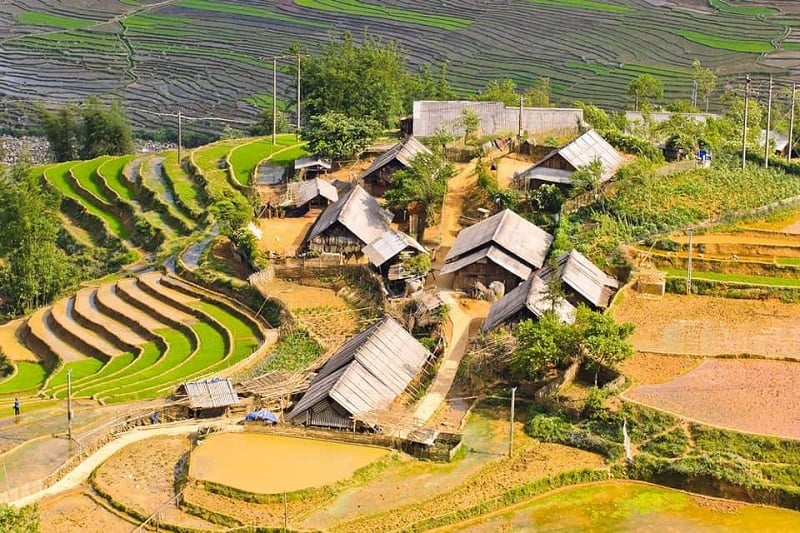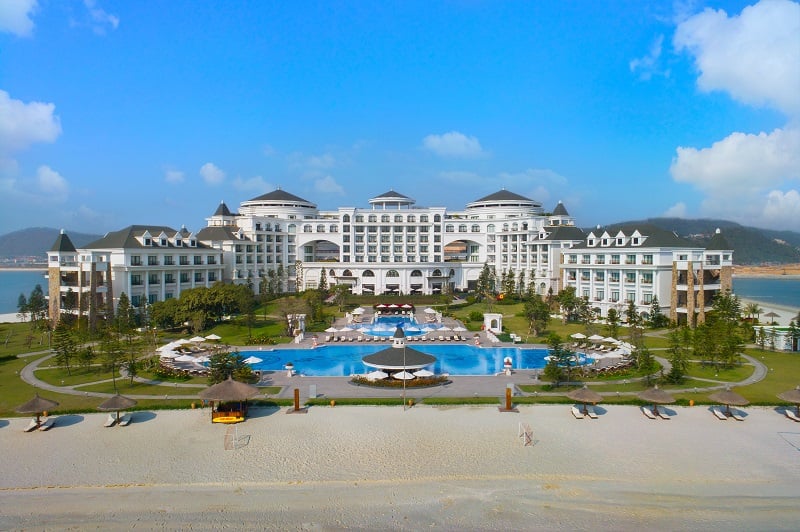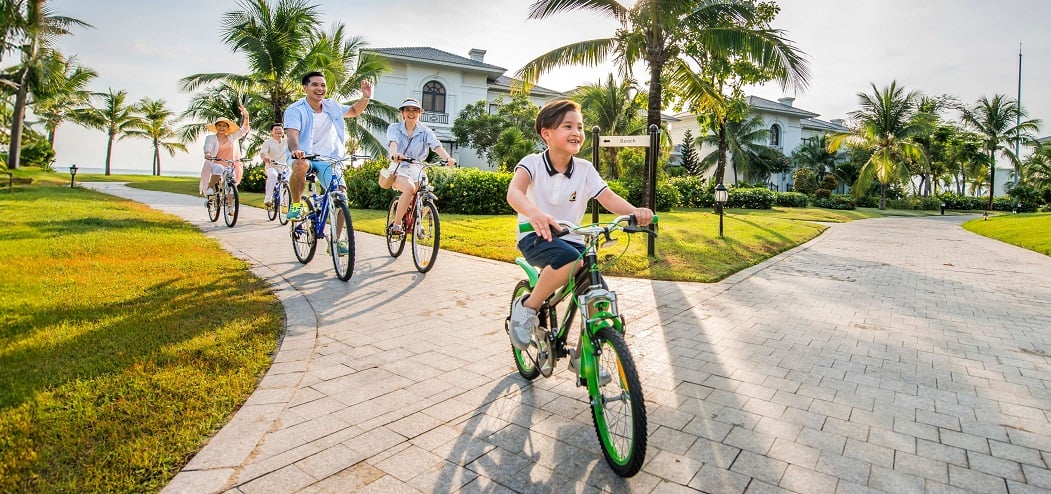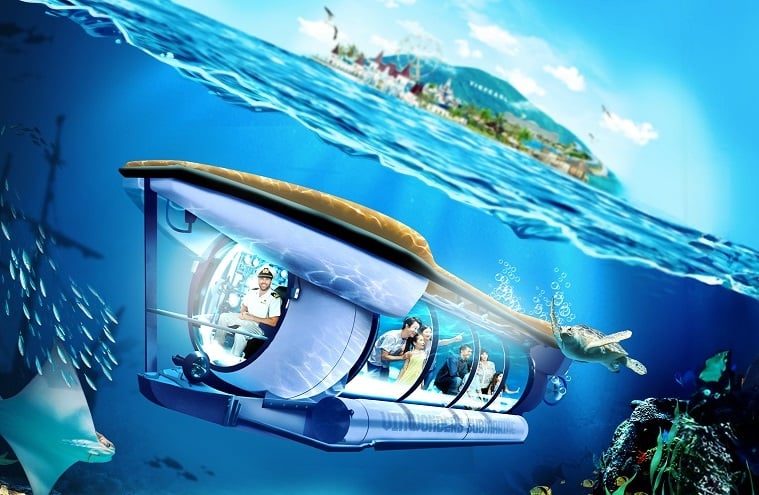
Welcome to Sapa, Vietnam - a hidden gem nestled in the mountainous region of the country. Sapa is a place of natural beauty, with cascading rice terraces, misty valleys, and majestic peaks. It is also a cultural hub, home to several ethnic minority groups with unique customs and traditions. Join us as we explore this magical destination and discover the wonders of Vietnam travel.
1. About Sapa, Vietnam: Location and weather
Sapa, Vietnam is situated in the northwestern region of the country, close to the Chinese border. It is surrounded by mountains that are part of the Hoang Lien Son range, with Fansipan being the highest peak in Indochina.
Sapa's weather is characterized by its four seasons, with each season offering a unique charm. Summer is warm and humid, while winter is cold and dry, with occasional snowfall. Autumn and spring are the best time to visit Sapa, as the weather is mild, and the town is covered with colorful foliage, making it a perfect destination for hiking, trekking, and sightseeing.

>>> Read more: Climate in Vietnam: Details about weather, temperature, and more
2. Top 10 well-known tourist attractions in Sapa, Vietnam
2.1. Ham Rong Mountain
If you are planning a trip to Sapa, Vietnam, you absolutely cannot miss out on Ham Rong Sapa Mountain. This majestic peak is one of the most beloved Sapa tourist attractions.
Ham Rong Mountain offers stunning panoramic views of Sapa and its surroundings, including the lush green valleys and majestic mountains that stretch as far as the eye can see.
Legend has it that the mountain is named after a dragon that once lived in the region. According to the story, the dragon was so large that it could coil around the entire mountain. Today, you can still see the rock formations that resemble a dragon’s head and tail.

2.2. Sapa Stone Church
Sapa Stone Church is a must-visit attraction in Sapa, Vietnam for those interested in history and architecture. Built by French missionaries in the 19th century, the church is an iconic landmark in the region, with its stunning stone facade and Gothic-style architecture.
The interior of the church is equally impressive, with intricate stained-glass windows, wooden pews, and a soaring ceiling that creates a sense of grandeur and tranquility.

2.3. Cat Cat Village Sapa
Cat Cat Village is home to the H'mong ethnic minority group, one of the largest ethnic groups in Sapa.
This village is known for its stunning natural beauty, including lush rice terraces, cascading waterfalls, and verdant hillsides. Visitors can explore the village's narrow alleys, visit traditional H'mong homes, and learn about the process of making traditional H'mong clothes and crafts.
2.4. Fansipan Mountain
Fansipan Mountain is the highest peak in Vietnam, Laos, and Cambodia, and one of the most popular destinations in Sapa, Vietnam. Known as the "Roof of Indochina," Fansipan Mountain offers breathtaking views of the surrounding mountains and valleys, with its peak often shrouded in mist and clouds.

Climbing Fansipan Mountain is a challenging but rewarding activity, with several trekking routes available to choose from, depending on your level of fitness and experience. A trek to the summit of Fansipan Mountain is not for the faint-hearted, but the sense of accomplishment and the stunning views make it a once-in-a-lifetime experience that is not to be missed.
For those seeking a less challenging way to experience Fansipan Mountain, a cable car ride is also available. The cable car takes visitors from the base of the mountain to the summit, with stops at several scenic viewpoints along the way.
2.5. Ta Van Village
Ta Van Village is home to the Giay ethnic minority group, known for their unique culture and traditions.
One of the highlights of visiting Ta Van Village is exploring the stunning rice terraces that surround the village. The terraces are a marvel of human engineering, with each field carved into the steep mountainside by hand.

Another popular activity in Ta Van Village is visiting the traditional Giay houses. These stilt houses are made from local materials such as bamboo, wood, and palm leaves, and feature unique architectural designs that reflect the Giay culture. Visitors can explore the houses, learn about the traditional way of life, and even participate in local customs such as making rice wine or weaving textiles.
2.6. O Quy Ho Pass
O Quy Ho Pass connects Lai Chau province with Lao Cai province, and is one of the four great mountain passes in Vietnam, reaching a peak altitude of over 2,000 meters above sea level. The pass boasts stunning views of the surrounding mountains and valleys, with lush forests, rolling hills, and winding rivers stretching as far as the eye can see.

One of the highlights of visiting O Quy Ho Pass is stopping at the many scenic viewpoints along the way. These viewpoints are perfect for taking memorable photos and soaking up the natural beauty of the area.
2.7. Sapa Silver Waterfall
Sapa Silver Waterfall is a stunning natural attraction located just outside of Sapa, in Lao Cai province. The waterfall is among the most popular Sapa tourist attractions, and is known for its sparkling, silver-like appearance, which is caused by the sun reflecting off the water as it cascades down the rocky cliff.
The waterfall is approximately 200 meters high and can be reached by a short hike through the surrounding forest. Along the way, visitors will have an opportunity to admire the lush vegetation and enjoy the fresh mountain air. Once at the waterfall, visitors can take in the stunning views and feel the refreshing mist on their faces as the water crashes down into the pool below.

2.8. Muong Hoa Valley
Muong Hoa Valley, a breathtakingly beautiful valley located in Sapa, Vietnam, is considered one of the most picturesque and scenic areas in the region. The valley is home to many traditional villages of the Hmong and Dao ethnic groups.
Visitors to Muong Hoa Valley can choose to explore the area on their own or take a guided tour, which can provide a more in-depth understanding of the history and culture of the region. Whether you prefer hiking through the stunning landscapes, experiencing the unique cultural traditions, or simply admiring the natural beauty, Muong Hoa Valley is a must-visit destination for anyone traveling to Sapa, Vietnam.
2.9. Sapa Love Market
The Love Market, one of the most well-known markets in Sapa, is a place where young people from different ethnic groups in the region gather to socialize and find potential partners. It brings a unique opportunity to witness the traditional courting customs of the Hmong, Dao, and Giay people, who dress up in their traditional costumes and engage in singing, dancing, etc.
Apart from the cultural aspect of the Love Market, visitors can also browse the many stalls selling local handicrafts, textiles, and foods. The market is a great place to buy authentic souvenirs and try local delicacies, such as roasted pork, grilled fish, and sticky rice cakes.
2.10. Tram Ton Pass
Tram Ton Pass, also known as Heaven's Gate, is a breathtaking mountain pass located in the Hoang Lien Son mountain range in Northern Vietnam. It is the highest mountain pass in Vietnam, reaching an elevation of 1,900 meters above sea level. The pass is located on the road that connects Sapa and Lai Chau, offering stunning views of the surrounding mountains and valleys.

The name Heaven's Gate is derived from the breathtaking views of the clouds and sky that can be seen from the pass, especially during sunrise and sunset.
Tram Ton Pass is a popular destination for visitors to Sapa, Vietnam who are looking for a scenic ride. The road winds through the mountains, offering panoramic views of the surrounding landscapes. Visitors can also stop at various viewpoints along the way to take photos and enjoy the scenery.
>>> Read more: Vietnam where to go: The 10 HOTTEST destinations in 2024
3. The complete guide for your upcoming Sapa, Vietnam tour
3.1. When is the best time to visit Sapa?
The best time to visit Sapa is from September to November and from March to May. During these months, the weather is relatively mild, with clear skies and cool temperatures, making it perfect for outdoor activities such as hiking and exploring the surrounding countryside.

In September and October, the rice fields in Sapa turn golden yellow, creating a stunning spectacle that attracts many visitors. This period is known as the rice harvest season, and it is an excellent time to witness the local farmers harvesting their crops.
From March to May, the weather is pleasant and mild, with a lot of sunshine and blooming flowers. This period is perfect for trekking and exploring the scenic landscapes of Sapa. The average temperature during this time ranges from 15°C to 25°C.
During the winter months of December to February, the temperature in Sapa drops considerably, and it can get very cold, with occasional snowfall. While this time of year can be charming, it may not be suitable for outdoor activities, particularly trekking or hiking.
3.2. How to get to Sapa, Vietnam?
There are several ways to get to Sapa, Vietnam, depending on your preferences and budget.

- By plane: The closest airport to Sapa is Noi Bai International Airport in Hanoi. From there, you can take a private car or shuttle bus to Sapa, which takes around 5-6 hours.
- By train: There is no direct train from Hanoi to Sapa. You need to take a train from Hanoi to Lao Cai, which is the closest town to Sapa. The train journey takes around 8 hours and offers stunning views of the Vietnamese countryside. From Lao Cai, you can take a shuttle bus or taxi to Sapa, which takes around 1 hour.
- By bus: Taking a bus from Hanoi to Sapa is another affordable and convenient option. There are several bus companies that offer direct buses from Hanoi to Sapa, which takes around 6-7 hours. The buses are usually comfortable, and some even offer Wi-Fi.
Once you arrive in Sapa, you can rent a motorbike or car to explore the surrounding areas or book a tour with a local guide. There are also many walking trails and hiking routes that you can explore on foot, allowing you to fully immerse yourself in the stunning scenery and local culture.
3.3. What to eat on your trip to Sapa?

If you are a foodie, Sapa, Vietnam is a great destination to explore the local cuisine of Northern Vietnam. Here are some must-try food in Sapa:
- Thang Co: This is a traditional stew made with horse meat, organs, and bones.
- Salmon hotpot: This hotpot is usually served with vegetables, noodles, and a spicy dipping sauce.
- Grilled pork sausage: This delectable sausage made from finely minced pork, garlic, and various spices is a local specialty.
- Black chicken: The chicken is slow-cooked with Chinese herbs and served with rice or noodles.
- Bitter bamboo shoot soup: This signature soup of Sapa, Vietnam incorporates bitter bamboo shoots, pork, and an assortment of herbs to create a distinctive flavor.
>>> Read more: Vietnamese food: The TOP 10 must-try dishes in 2024
3.4. Where to stay in Sapa?
Sapa offers a variety of accommodation options for travelers, ranging from guesthouses, homestays in ethnic villages, hostels, budget hotels, to luxurious 3-5 star hotels and secluded resorts.

Many visitors prefer to stay in homestays or hostels for an authentic experience. You can find Sapa homestays in Cat Cat, Lao Chai, and Ta Van villages to immerse yourself in the peaceful surroundings of the mountains.
The prices for a hotel in Sapa vary, depending on the type of accommodation you choose. Generally, the prices range from 100,000 VND per night for a dorm bed to 500,000 VND per night for a double room. For those seeking more luxury, there are also high-end resorts and hotels available, with prices starting from 2,000,000 VND per night.
>>> Read more: Vietnam hotels: The top 14 options for a fabulous stay with your family
Vietnam is a land of enchanting and diverse destinations that will leave you spellbound. Beyond Sapa, you will find a wealth of other alluring tourist hotspots like the tropical paradise of Phu Quoc, the seaside haven of Nha Trang, the historical wonderland of Hoi An, the dynamic city of Da Nang, and the mystical Ha Long Bay - all of which promise stunning scenery, a wealth of cultural treasures, and thrilling experiences that will satisfy every kind of traveler.
When planning your next adventure, securing top-notch accommodation is essential for a truly unforgettable trip. And if you are looking for the ultimate luxury and comfort, Vinpearl should be at the top of your list.

With an exclusive collection of hotels and resorts situated in Vietnam's most coveted destinations like Vinpearl Phu Quoc, Vinpearl Nha Trang, Vinpearl Resort & Golf Nam Hoi An, and Vinpearl Resort & Spa Ha Long, you can expect nothing less than an exceptional experience at Vinpearl.
From relaxing spas to delectable dining options, each Vinpearl property is equipped with world-class amenities and offers splendid views of the surrounding landscapes.
>>> Book rooms in Vinpearl Phu Quoc, Vinpearl Nha Trang, Vinpearl Resort & Golf Nam Hoi An, Vinpearl Resort & Spa Ha Long for an indulgent and unforgettable experience!

Sapa, Vietnam is a destination that captures the hearts of travelers from all over the world. From the stunning rice terraces to the vibrant markets, from the picturesque villages to the towering mountain ranges, Sapa has everything to offer. Moreover, Sapa, Vietnam provides a chance to experience the hospitality and way of life of the local ethnic groups. Why wait? Plan your trip today and discover the magic of Sapa for yourself.
























